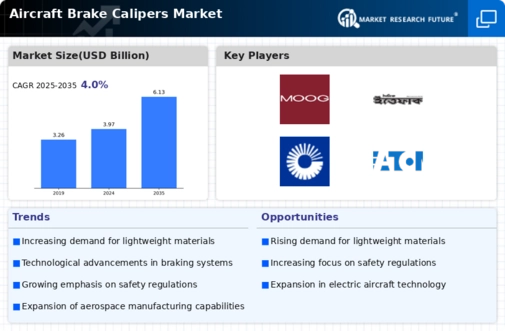Market Trends and Future Projections
The Global Aircraft Brake Calipers Market Industry is poised for dynamic growth, with projections indicating a market size of 3.97 USD Billion in 2024 and a potential increase to 6.13 USD Billion by 2035. The compound annual growth rate of 4.02% from 2025 to 2035 reflects the industry's resilience and adaptability to changing market conditions. Key trends influencing this growth include advancements in technology, regulatory compliance, and the expansion of air travel. As these factors converge, the market is likely to evolve, presenting opportunities for innovation and investment in aircraft brake calipers.
Growth in Air Travel and Fleet Expansion
The Global Aircraft Brake Calipers Market Industry is significantly influenced by the growth in air travel and the subsequent expansion of aircraft fleets. As global passenger traffic continues to rise, airlines are compelled to invest in new aircraft, which in turn drives the demand for brake calipers. This trend is particularly pronounced in emerging markets, where increasing disposable incomes and urbanization are contributing to a surge in air travel. By 2035, the market is anticipated to reach 6.13 USD Billion, underscoring the correlation between fleet expansion and the necessity for reliable braking systems. This growth trajectory indicates a robust future for the brake caliper segment.
Increasing Demand for Aircraft Maintenance
The Global Aircraft Brake Calipers Market Industry experiences a notable uptick in demand due to the growing emphasis on aircraft maintenance. As airlines and operators prioritize safety and efficiency, regular maintenance schedules are being implemented more rigorously. This trend is particularly evident in regions with aging fleets, where the need for reliable braking systems becomes paramount. The market is projected to reach 3.97 USD Billion in 2024, reflecting the industry's response to these maintenance needs. Enhanced regulatory frameworks further drive this demand, ensuring that aircraft brake calipers are maintained to the highest standards, thereby fostering a robust market environment.
Regulatory Compliance and Safety Standards
Regulatory compliance and safety standards are critical drivers of the Global Aircraft Brake Calipers Market Industry. Governments and aviation authorities worldwide are enforcing stringent regulations to ensure the safety and reliability of aircraft components, including brake systems. These regulations necessitate the use of high-quality brake calipers that meet specific performance criteria. As a result, manufacturers are compelled to innovate and enhance their product offerings to comply with these standards. This focus on safety not only protects passengers but also fosters consumer confidence in air travel, thereby positively impacting market growth. The ongoing evolution of safety regulations suggests a sustained demand for advanced brake calipers.
Technological Advancements in Brake Systems
Technological advancements play a pivotal role in shaping the Global Aircraft Brake Calipers Market Industry. Innovations such as lightweight materials and advanced hydraulic systems are being integrated into brake caliper designs, enhancing performance and reducing wear. These developments not only improve safety but also contribute to fuel efficiency, which is increasingly crucial in the aviation sector. As airlines seek to optimize operational costs, the adoption of these advanced brake systems is likely to accelerate. The market is expected to witness a compound annual growth rate of 4.02% from 2025 to 2035, indicating a strong alignment with technological progress and market demand.
Emerging Markets and Regional Growth Opportunities
Emerging markets present substantial growth opportunities for the Global Aircraft Brake Calipers Market Industry. Regions such as Asia-Pacific and Latin America are witnessing rapid economic development, leading to increased investments in aviation infrastructure. This growth is accompanied by a rising demand for new aircraft and, consequently, for advanced braking systems. As airlines in these regions expand their fleets to accommodate growing passenger numbers, the need for reliable brake calipers becomes increasingly pronounced. The potential for market expansion in these areas indicates a favorable outlook for manufacturers and suppliers, who may capitalize on the burgeoning aviation sector.















Leave a Comment